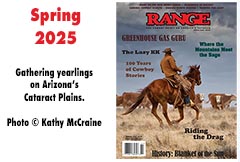|
Pristine Nature:
The
Founding
Falsehood
Banishing
livestock is
a death
sentence for
the lands of
the
Southwest. By Steven H.
Rich
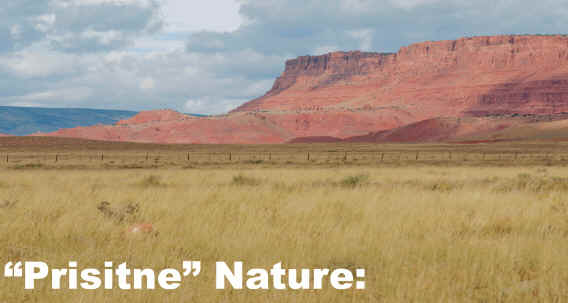 |
Still
resilient
after
years
of
severe
drought,
this
ranchland
(left)
in
Houserock
Valley,
Ariz.,
beneath
the
Paria
Plateau
cliffs,
still
provides
an
abundance
of
grasses
and
forbs. |
| The
Founding
Falsehood |
|
Why
leaving
„natureš
alone
means
destruction
of the
wilderness.
By
Steven
H.
Rich
. |
|
Brave
Daniel
Boone,
the
famous
bear
hunter,
warrior
and
frontiersman,
described
some
wilderness
areas
of the
Southern
Appalachians
as
"so
wild
and
horrid
that
it is
impossible
to
behold
them
without
terror."
Why?
Because
the
frontier
of
Daniel
Boone's
experience
was
not a
wilderness.
Though
made
up of
native
organisms,
it was
a
human-created
landscape
full
of
food
and
useful
plants.
Native
Americans
had
managed
the
woodlands
and
grasslands
to
produce
native
game
animals,
native
birds
and
fish,
native
seeds,
berries,
nuts,
greens,
fruits,
bulbs,
corms,
mushrooms,
roots,
basketry
and
cordage
materials,
firewood,
weapon-making
and
building
materials,
medicines
and
ceremonially
important
plants
by
processes
collectively
called
"proto-agriculture."
They
burned
the
brush
to
prevent
catastrophic
wildfire
and to
increase
wildlife
and
visibility
for
military
reasons.
The
very
soils
were
changed
by
their
activities.
Many
"wild"
native
plants
that
exist
today
are in
fact
the
products
of
ancient
Native
American
genetic
selection
and
propagation
projects |
that
favored
better-tasting
or
more
useful
versions.
The
sight
of a
wild,
trackless,
impenetrable,
dense
forest
or
barren,
brushy
tangle
(both
subject
to
huge
devastating
wildfires)
with
little
animal
life
and
nothing
to eat
repulsed
Boone,
as it
did
the
Native
Americans
of his
time.
He was
used
to
productive,
gentled
native
landscapes
--humanized
landscapes
full
of
bears,
deer,
rabbits
and
squirrels.
Advocates
for a
return
to „pristinešnature
demand
an end
to
ranching,
claiming
that
ranchers
„alterš
what
activists
imagine
to be
„naturalš
ecosystems.
Water
holes,
water
troughs,
erosion
controls,
irrigation,
seeding,
grazing,
clearing
brush,
making
a
living
on the
land,
hunting
and
fishing
are
all
castigated
as
wrong
and
bad.
These
angry
activists
want
to „restorešwhat
they
suppose
was
the
„pre-Columbianš
or „pre-contactš
condition
where,
they
say,
humans
„had
little
influenceš
on
ecosystems.
Health
and
biodiversity
with
human
assistance,
in
their
minds,
seems
to be
a
distortion
of the
natural
order. |
Anything
that
happens
in
nature
without
humans
is
sold
by
them
as
desirable
and
good,
no
matter
how
destructive
of
ecosystem
values,
no
matter
how
many
species
of
native
plants
and
animals
are
lost.
This
odd,
irresponsible
position
has
been
adopted
because
after
years
of „ridding
the
land
of
human
influencesš
the
health
and
biodiversity
they
promised
from
„returning
things
to
natureš
never
happened.
They
fundamentally
misunderstood
the
causes
of
ecosystem
health.
Very
positive
ecological
effects
of
well-managed
livestock
--so
valuable
that
experts
recommend
paying
skilled,
responsible
ranchers
for
the
ecosystem
services
they
provide
--are
contemptuously
rejected
by
doctrinaire
„environmentalistsš
as
more
„alteration.š
Stranger
still,
ranchers'
so-called
„changesš
generally
cause
the
landscape
to
look
much
more
like
the
West
their
ancestors
encountered
in the
early
1800s,with
a mix
of
successional
communities
in a
mosaic
pattern. |
| With
their
lawsuits
against
ranchers,
these
activists
destroy
rural
communities,
then
claim
"environmental
success"
as
defined
by
themselves
as
judges,
juries,
executioners
and
arbiters
of all
things
environmental.
Biodiversity
and
health,
they
claim,
will
show
up in
a few
centuries
or so.
Popular
beliefs
which
imagine
pre-Columbian
America
as a
"pristine
wilderness"
(including
the
West)
are
false,
and
are
based
on
racist
stereotypes.
The
highly
successful
and
extremely
intelligent
adaptations
and
achievements
of
Native
American
societies
are
reduced
to the
instinctual
behavior
of
wildlife
("noble
savages
in a
state
of
nature").
The
related
notion
that
"protecting"
land
in the
West
from
all
human
influences
preserves
biodiversity
long-term
is
also
false.
It
actually
endangers
and
destroys
the
biodiversity,
health,
and
stability
of
these
lands.
The
romantic
notion
of the
Americas
as
pristine
wilderness
was
created
in a
prior
century
by
people
who
could
not
fathom
the
idea
of
Native
Americans
creating
natural
paradises
through
deep
knowledge
of
nature
and
hard
work. Most
people
today
have
little
experience
with
nature
and
have
inherited
what
amounts
to
15th
through
19thcentury
Eurocentric
propaganda
--the
"pristine"
myth.
A
scholarly
paper,
"The
Pristine
Myth:
The
Landscape
of the
Americas
in
1492,"
by
William
N.
Denevan
of the
University
of
Wisconsin
(one
of
many
works
on the
subject),
begins
with
an
abstract
which
sums
up the
facts:
"The
myth
persists
that
in
1492
the
Americas
were
as
parsely
populated
wilderness
--a
world
of
hardly
perceptible
human
disturbance.
There
is
substantial
evidence,
however,
that
the
Native
American
landscape
of the
sixteenth
century
was a
humanized
landscape
almost
everywhere.
Populations
were
large.
Forest
composition
had
been
modified,
grasslands
had
been
created,
wildlife
[populations
modified],
erosion
was
severe
in
places.
Earthworks,
roads,
fields,
and
settlements
were
ubiquitous.
With
[Native
American]
depopulation
in the
wake
of Old
World
disease,
the
environment
had
[fewer
fields
and
villages
and
had
become
more
proto-agricultural
than
agricultural]
in
many
areas.
A good
argument
can be
made
that
the
human
presence
was
less
visible
in
1750
than
it was
in1492."
The
Native
American
depopulation
was a
tragedy
believed
to
have
killed
up to
90
percent
of
Native
Americans
within
200
years
of
original
exposure
to
European
diseases,
to
which
they
had no
immunity.
Millions
still
survived
in
North
and
South
America.
It
pleased
European
consciences
to
imagine
the
land
as
free
for
the
taking.
According
to
Denevan:
"The
pristine
view
is to
a
large
extent
an
invention
of
nineteenth
century
romanticist
and
primitivist
writers
such
as
Hudson,
Cooper,
Thoreau
[who
was
terrified
the
one
time
he
experienced
actual
wilderness],
Longfellow
and
Parkman,
and
painters
such
as
Catlin
and
Church." |
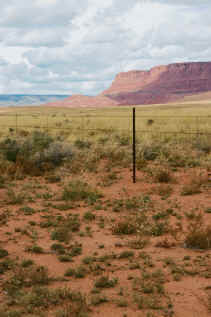 |
Grazed
land
behind
the
fence
is a
historic
source
of
seeds,
greens,
basket
materials
and
hunting
opportunities
for
the
Native
Americans
who
left
ruins
nearby.
The
land
in
front
of the
fence
is
clearly
dying
from
years
of
"rest." |
| The
notion
that
we can
give
up
awareness,
learning,
work
and
discipline,
and
live
by
impulse
and
instinct,
was
fashionable
with
these
writers
and
their
friends.
The
allegedly
"spontaneous"
and
"natural"
abundance
of
allegedly
"pristine"
and
"pagan"
America
was
the
ultimate
proof
of
their
philosophy
and
the
ultimate
reproof
of
strait-laced
work
and
sacrifice-oriented
Judeo/Christian
civilization,
which
they
saw as
the
enemy
of
pristineness
and
spontaneity.
"Environmentalist"
ideas
of
spontaneous
land
health
exist
in
direct
lineal
descent
from
these
romantic
fallacies.
Denevan
quotes
John
Bakeless
as an
example
of
confused
writers
who
passed
on the
irrational
myth
in the
1950s:
"There
were
not
really
very
many
of
these
redmen∑the
land
seemed
empty
to
invaders
who
came
from
settled
Europe∑that
ancient,
primeval,
undisturbed
wilderness∑."
Bakeless
recounted
their
observations
of
what
we now
know
were
the
benefits
of
Native
American
proto-agricultural
management
practices.
But
the
Europeans
blindly
and
unknowingly
gave
random
nature
the
credit:
"The
streams
simply
boiled
with
fish...so
much
game
that
one
hunter
counted
a
thousand
animals
near a
single
salt
lick...the
forested
glory
of
primitive
America....
Indian
prairie
fires
caused
the
often
mentioned
oak
openings...great
fields
of
[Native
American
planted]
corn
spread
in all
directions...the
Barrens
[mountaintop
grasslands]
without
forest,
and
early
Ohio
settlers
found
that
they
could
drive
about
through
the
forests
with
sleds
and
horses."
Native
Americans
had
cleared
them
of
brush.
The
glaring
contradiction
between
his
data
and
his
beliefs
was
lost
on
Bakeless
and
nearly
everyone
else,
so
cocksure
and
religiously
enamored
were
they
of the
false
but
seductive
idea
that
nature
would
reach
a
healthy,
productive
balance
spontaneously
if
humans
left
it
alone.
Early
settlers
and
their
Native
American
contemporaries
were
not
fond
of
living
in
places
that
were
not
altered
by
humans.
On the
topic
of
intellectual
inconsistency,
Denevan
continues:
"Scholarship
has
shown
that
Indian
populations
in the
Americas
were
substantial,
that...landscape
change
was
commonplace. |
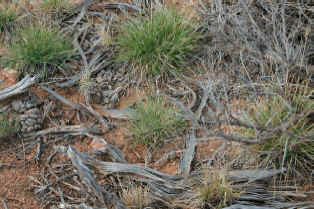 |
| Tufts
of
green
grass
(above)
are
as
clear
a
sign
as
the
deer
droppings
that
this
dry
country
welcomes
animal
life.
Below:
Managed
ranchland
like
this
was
a
rich
larder
for
early
Native
Americans
who
planted
part
of
their
harvest
to
ensure
a
variety
and
abundance.
It
took
an
average
of
10
to
20
times
more
unmanaged
plants
to
serve
a
cultural
need
than
those
from
productive,
managed
lands. |
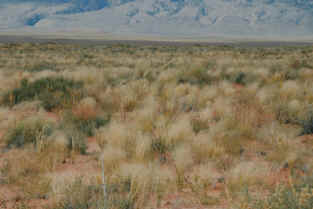 |
|
|
This
message,
however,
seems
not
to
have
reached
the
public
through
texts,
essays
or
talks
by
both
academics
and
popularizers
who
have
a
responsibility
to
know
better.š
Well-established
facts
have
been
purposefully
left
out
of
the
textbooks,
journals
and
discussions.
Academics
and
the
media
are
participating
in
this
deception
either
through
active
suppression
of
the
truth
or
by
an
inexcusable
ignorance.
Land
health
and
native
diversity
suffer
seriously
from
this
widespread
misunderstanding.
Respected
Native
American
elders
remember
better
times.
„The
white
man
sure
ruined
this
country,š
said
Southern
Sierra
Miwok
(from
California)
elder
Jim
Rust.
„It's
turned
back
to
wilderness.
In
the
old
days
there
used
to
be
lots
more
game:
deer,
quail,
gray
squirrels
and
rabbits.š |
Natives
of
Payson,
Ariz.,
an
area
under
Apache
tribal
stewardship
for
many
hundreds
of
years,
have
documented
that
over
1,000
miles
of
former
trout
streams
have
dried
up
in
the
last
70
years,
along
with
many
large
and
small
springs
within
a
50-mile
radius
of
Payson.
This
is
due
to
brush
and
tree
encroachment
on
former
chaparral
and
ponderosa
pine
zone
grasslands
created
and
maintained
by
Apache
and
earlier
tribes'
use
of
prescribed
fire
and
the
resultant
impact
by
elk,
bison,
deer,
and
wild
sheep.
Native
Americans
were
consciously
aware
of
many
sophisticated
elements
of
landscape
hydrology,
even
to
the
extent
of
affecting
snowpack
densities.
They
managed
to
maintain
and
increase
stable
stream
flows
by
such
means
as
creating
the
grasslands
which
rapidly
build
absorbent
soil
organics,
stabilize
soils |
|
and
use
vastly
less
water
than
the
woody
species
now
dominating
most
of the
West.
The
problems
are
due to
policies
corrupted
by
"pristine"
mythology.
Consider
these
statements
about
shrinking
biodiversity
under
politically
correct
management
by
environmentalist
Bill
Bryson,
author
of
"A
Walk
in the
Woods":
"The
National
Park
Service
actually
has
something
of a
tradition
of
making
things
extinct.
Bryce
Canyon
National
Park
is the
most
striking
example.
It was
founded
in
1923
and in
less
than
half a
century...lost
seven
species
of
mammal
--the
white-tailed
jackrabbit,
prairie
dog
[grassland
species],
pronghorn
antelope,
flying
[Abert]
squirrel,
beaver,
red
fox,
and
spotted
skunk....Altogether
42
species
of
mammals
have
disappeared
from
America's
National
Parks
this[20th]
Century."
All of
these
animals
mentioned
as
extinct
in
Bryce
Canyon
National
Park
still
live
on
nearby
ranches.
Why
have
the
park
habitats
lost
species?
The
answer
lies
in how
hard,
raw,
random
nature
functions.
Contrary
to
popular
belief,
rangeland
ecosystems
do not
self-organize
into
biodiverse,
productive,
stable
communities
without
appropriate
disturbance.
Ecosystems
can go
on
collapsing
for
hundreds
of
years.
Below
certain
thresholds,
recovery
is not
possible
without
human
intervention.
"Survival
of the
fittest"
left
to
itself,
works
out in
practice
to
mean
landscapes
under
the
pitiless
rule
of the
aggressive
bullies
among
adapted
species
and
abiotic
(nonliving)
forces
such
as
wildfire,
drought
and
floods.
After
a few
decades,
rangelands
end up
with a
very
few
plant
species
covering
vast
areas
(each
valuable
as
apart
of a
broader
community),
sad
remnants
of a
possible
hundred
or
more.
These
survivors
are
the
tallest,
meanest,
and
often
most
toxic
plants
that
can
live
there.
The
ground
between
them
is
bare.
The
soil
erodes.
Soils
also
degrade
in
place
(lose
nutrients
and
water-holding
capacity)
as
soil
organics
are
used
up
faster
than
the
roots
of
woody
plants
can
replace
them.
Soils
are
dried
by
rapid
drainage
of
resulting
rills
and
gullies
and
the
heavier
water
uses
of
trees
and
shrubs.
Springs
and
streams
dry
up.
Often,
insects
like
ants
make
up the
bulk
of
animal
biomass.
All
these
factors
would
be
obvious
to any
organic
gardening
expert.
Sagebrush,
piĖon
and
juniper,
chaparral
species
and
salt
desert
shrub
species
force
out
the
grass
and
flower
understories
over
time
causing
serious
degradation.
So do
many
other
conifers
and
woody
plants.
Biodiverse
communities
of
aspen
trees
with
nontoxic,
nourishing
leaves
and
bark,
nurturing
nontoxic
grasses
and
flowers
have
declined
by
60to
90
percent
since
European
settlement,
according
to
research
quoted
by
Charles
Kay in
"Is
Aspen
Doomed?" |
Leave
the
land
alone
and
it
will
collapse.
With
lush
ranch
land
all
around,
rested
land
submits
a
harvest
of
decay.
Clockwise
from
top
left:
Grasses
struggle
to
survive
on
bare,
eroding
ground.
 Turf-type
grass
and
bunchgrass,
rested
to
death. Turf-type
grass
and
bunchgrass,
rested
to
death.
 "Pristine"
rice
grass
on
rested
land. "Pristine"
rice
grass
on
rested
land.
 Left
to
die,
this
sage
is
being
crowded
out
by
piĖon
and
juniper,
no
longer
controlled
by
prescribed
burning. Left
to
die,
this
sage
is
being
crowded
out
by
piĖon
and
juniper,
no
longer
controlled
by
prescribed
burning.
 Only
the
cryptogams
(flowerless,
seedless
fungi
and
algae)
can
live
on
this
rested
plot. Only
the
cryptogams
(flowerless,
seedless
fungi
and
algae)
can
live
on
this
rested
plot.
 Desolate
gray
is
the
color
of
"pristine";
note
the
grayish
cryptogamic
crust
of
algae
and
lichens. Desolate
gray
is
the
color
of
"pristine";
note
the
grayish
cryptogamic
crust
of
algae
and
lichens.
 Soils
lose
nutrients
and
water-holding
capacity
as
soil
organics
are
used
up
faster
than
the
roots
of
woody
plants
can
replace
them. Soils
lose
nutrients
and
water-holding
capacity
as
soil
organics
are
used
up
faster
than
the
roots
of
woody
plants
can
replace
them. |
|
| from
the
Journal
of
Forestry,
May
1997.Aspens
have
been
replaced
by
conifers
which
have
foliage
containing
high
toxin
levels.
The
former
large
aspen
populations
were a
result
of
management
by
Native
Americans
who
used a
tamed,
gentled
and
controlled
version
of
fire
to
control
the |
conifers
that
use
bullying
tactics
like
overshading,
competition
for
water
and
nutrients,
and
exuding
root
and
leaf
toxins
to
kill
other
plants
or
prevent
their
germination.
The
loss
of
these
vast
human-created
aspen
areas
is a
huge
blow
to
wildlife
and |
watershed
values
Conifers
do
produce
small
seasonal
nuts
and
serve
wildlife
as
cover
and
nesting
habitat,
but
very
few
animal
species
can
eat
much
of the
foliage.
Dense
conifer
forests
have
barren
understories.
Also,
deciduous
aspens
use
far
less
water
because
most
transpiration
stops
when
the |
|
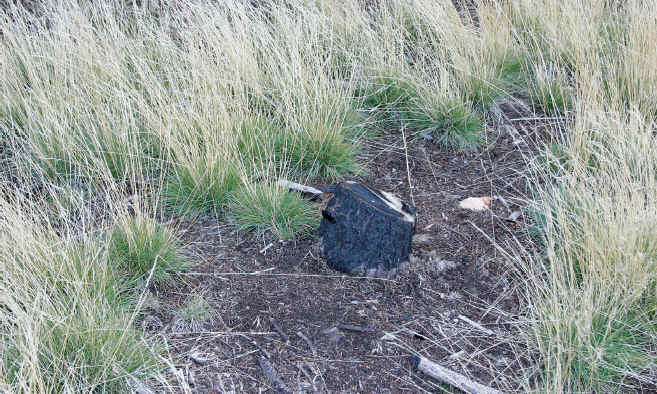
|
| Fire
and
flourishing
grasses
in
harmony.
After
piĖon/juniper
thinning
with
chain
saws,
and
a
cool,
fall
burn
on
the
grazed
site,
soil
organics
are
intact
and
encourage
a
rich
growth
of
native
grasses.
Native
Americans
who
retain
ancient
knowledge
about
fire
are
critical
of
modern
burning
and
fire-suppression
practices
which
often
damage
soil
and
plant
communities
and
cause
erosion
and
floods. |
|
|
leaves
fall.
Native
Americans
created
very
large
areas
of
pine
savannah
in
places
such
as
Arizona's
Mogollon
Rim
country.
Ponderosa
pines
and
other
conifers
now
number
in the
hundreds
and
thousands
per
acre
where
once
25
trees
per
acre
stood.
These
very
productive,
biodiverse,
high-altitude
grasslands
were a
paradise
for
many
species
and
produced
deep,
rich,
water-absorbent
soils.
These
human-created
pine
savannah
conditions
were
found
from
California,
Nevada,
Arizona
and
New
Mexico
to
Idaho,
Montana
and
the
Pacific
Northwest
in
ponderosa
forests.
They
were
the
result
of
low-severity,
prescribed-fire
frequencies
as
often
as
three
years
between
fires,
according
to Dr.
Wallace
Covington's
studies
at
Northern
Arizona
University.
Native
Americans
who
still
retain
ancient
knowledge
about
fire
use
are
very
critical
of
modern
prescribed-fire
practices
which
often
damage
soils
and
plant
communities
and
cause
erosion
and
floods. |
"My
great
aunt
and
mother
talked
about
how
the
land
was
burned,"
said
Nellie
Williams,
a
North
Creek
Mono
tribal
elder.
"If
there
was
brush
they'd
burn
the
ponderosa
pine
and
sugar
pine
areas.
I
remember
there
wasn't
the
tall
brush
there
is
now.
It's
hopeless
now
the
[government]
let it
go so
long.
So
when
it
does
burn
it
goes
and
kills
the
big
trees.
When
they'd
[Native
Americans]
burn,
it
wouldn't
hurt
the
trees."
Tree
numbers
were
kept
low by
burning
seedlings
and
saplings.
"They
would
burn
in the
fall
after
rains...but
it
wouldn't
burn
way
down
through
the
duff
like
it
does
with
the
controlled
burning
today."
Researchers
now
realize
that
most
"dry"
(without
saturated
soils)
mountain
meadowlands
which
recreationists
so
enjoy
were
created
and
maintained
or
enlarged
by
Native
Americans
in
late
prehistory
or
before.
Native
Americans
created
large
biodiverse
forb
and
grasslands
in the
West
both
in
mountain
and
valley
locations
for
roots
and
greens,
seed
harvest,
to
attract
game,
and
for
shelter,
basketry
and
cordage
materials
which
they
required
in
tremendous
amounts.
A
40-foot
deer
net
made
by the
Sierra
Miwok |
would
require
7,000
feet
of
string
or35,000
plant
stalks.
Managed
lands
were
more
productive
by
orders
of
magnitude.
It
took
an
average10
to 20
times
as
many
unmanaged
plants
to
serve
a
cultural
need
as it
did
managed
ones.
In the
prehistoric
and
late-historic
West,
researchers
are
certain
that
very
large
areas
were
burned
regularly
for
fire
protection
and
wildlife
management.
Grazing
and
the
required
management
practices
these
days
do
much
of
what
Native
Americans
accomplished
with
prescribed
fire,
and
connect
ranchers'
land
stewardship
with
their
predecessors.
Also,
fire
is
almost
always
a
"fire
and
animal
impact
treatment."
Wild
grazers
are
strongly
attracted
to
ashes
and
regrowth
after
fire.
Their
hoofprints,
dung,
urine,
bacterial
and
fungal
inoculations
are
important
to
recovery
after
fires.
To
modify
plant
growth
and
for
other
productive
purposes,
broad
additional
lands
were
burned,
irrigated,
pruned,
selectively
harvested,
sowed |
| (often
with
native
seeds),
tilled,
weeded,
or
transplanted
with
plants
and
cuttings
from
other
areas.
Where
they
wanted
wildlife
they
often
had it
in
abundance.
Early
trapper
Osborne
Russell,
in
"Journal
of a
Trapper,"
reported
large
herds
of
bighorn
sheep
in
Idaho,
Utah
and
Montana;
bison
from
horizon
to
horizon
in
Wyoming,
Montana
and
elsewhere;
elk,
deer
and
bighorns
in
Utah;
and a
herd
of
mule
deer
three
miles
long
in the
Black
Hills
in the
1840s.
Ethnologists
Anderson
and
Moratto
concisely
state
for
Sierra
Nevada
lands
what
was
true
for
much
of the
West:
"Until
recently,
vegetation
types
in the
Sierra
Nevada
were
viewed
as
`natural'
and
their
productivity
maintained
through
natural
disturbances
in the
complete
absence
of
human
influence.
It is
now
recognized
that
many
ecosystems...evolved
through
significant
human
intervention.
The
ability
of
Native
Americans
to
meet
their
economic
needs
was
sustained
not
only
through
hunting,
fishing
and
gathering,"
it was
also
maintained
through
the
activities
listed
above.
"Native
American
relationships
to
land
were
highly
interactive.
Areas
were
manipulated
annually,
biannually,
triennially
or
quadrennially
to
augment
wild
plant
populations
and
create
shifting
mosaics
of
different
vegetation
types."
Critical
information
is
condensed
in the
above
mention
of how
"ecosystem
productivity
is
maintained
through...disturbance."
Almost
all
ecosystems
are
disturbance-dependant.
Without
moderate
disturbance
they
grow
old
and
collapse,
unable
to
come
back
from
fire,
etc.,
and
lose
potential.
On
rangelands
few
species,
plant
or
animal,
survive
after
just a
few
decades
of
confused
"environmentalists"
getting
their
way.
Raw,
random
nature
moves
from
one
catastrophe
to the
next.
Prehistoric
humans
didn't
like
that.
They
softened
nature.
They
made
mistakes,
but
their
results
were
often
far
superior
to
those
from
modern
notions
in
terms
of
biodiversity,
productivity
and
health.
The
message
of
"humanized
landscapes"
is
best
understood
in the
original
sense
of the
word
"human"
which
was
similar
to
present
day
"humane."
Human
was
something
you
called
someone
to
honor
his or
her
kindness
and
intelligence.
Humanized
landscapes
had
rules,
courtesy
and
land
ownership.
Tribespeople
saw
themselves
as
stewards
and
guardians.
Their
land
ethic
required
respect
for
nature
and
the
right
of all
life
forms
to
survive.
So
they
tamed
fire,
knocked
back
the
aggressive
plants
and
animals
and
gave
the
cooperative,
edible
and
useful
ones a
big
edge.
Where
there
were
few
Indians,
white
explorers
starved.
Restoration
biologists
have
had to
adopt
native
practices
from
the
Sonoran
desert
to the
Great
Lakes.
Scientists
now
realize
that
many
wild
plants
and
communities
require
human-caused |
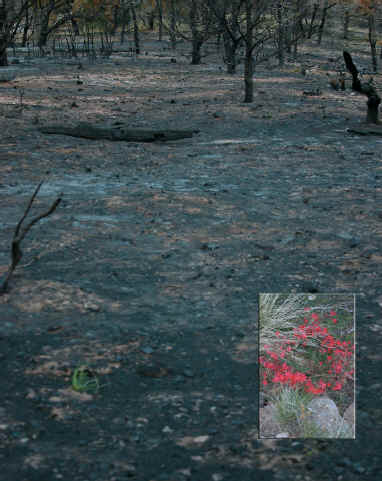 |
| After
a
wet
summer
and
fall,
a
thick
understory
allowed
a
too-hot
wildfire
to
destroy
everything
in
its
path.
Fire-following
survivors
are
the
tallest,
meanest,
and
often
most
toxic
plants
that
can
live
there,
like
cheatgrass,
turbinella
oak
and
catclaw.
Managed
fire
stimulates
new
growth.
Inset:
On
managed
ranch
land,
where
less
severe
fire
is
used
as
a
tool,
flowering
plants
bloom. |
|
|
| disturbance
to
persist.
Ancient
Native
Americans
of
the
West
are
best
understood
by
modernpeople
as
country
folks.
They
were
sophisticated
in
their
way
of
life
and
loved
their
land
and
animals.
Their
world
view
resembles
that
of
ranchers
and
farmers
far
more
than
that
of
advocates
for
ridding
nature
of
human
influences.
Under
no
circumstances
would
they
accept
the
radical
„get
the
human
influences
outš
viewpoint,
because
they
wouldn't
want
to
starve,
burn
to
death,
or
see
their
land
destroyed.
They
would
refuse
to
give
up
a
life
surrounded
by
freedom
and
beauty. |
Their
core
philosophies
centered
on
harmony
and
balance
and
they
saw
themselves
as
agents
and
guardians
of
that
balance.
Farmers
and
ranchers,
many
of
whom
are
Native
Americans,
are
the
inheritors
of
the
ancient
management
legacy.
The
natural
world
actually
requires
careful
nurturing,
not
self-righteous
neglect.
As
one
researcher
put
it,
there
were
no
„spontaneous
Edensš
on
earth.
The
New
World
paradises
were
created
by
the
sweat
of
millions
of
Native
Americans
caring
for
their
land.
Nowadays,
ranchers
who
have
received
this
responsibility
must
be
great
stewards. |
|
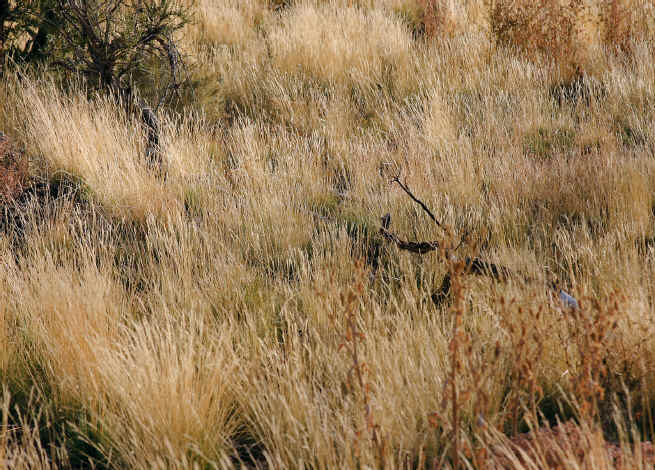 |
| Native
Americans
thinned
trees
by
building
fires
at
their
bases.
Thinning
increased
grassland,
improved
watershed,
and
promoted
greater
nut
production
from
remaining
trees.
The
explosive
growth
of
grass
(above)
is
the
result
of
tree
thinning
and
active
soils
maintained
by
livestock
and
subsequent
burning. |
|
| A
growth
industry
of „preservationš
fund-raisers
with a
selfish,
narrow,
monetary
interest
is
pushing
the
pristine
myth
for
profit.
If
they
don't
know
they're
lying,
they
ought
to.
Congress
and
the
American
people
have
charged
land
management
agencies,
including
the
National
Park
Service
and
U.S.
Fish
&
Wildlife
Service,
with a
duty
to
preserve
nature.
The
pristine
myth
cannot
continue
as the
theoretical
basis
of any
government
policy.
The
human-free,
pre-Columbian
condition
never
existed.
Trying
to
re-create
this
fictional,
imaginary
state
is not
some
sort
of
cheerful,
happy
little
fantasy.
It
grossly
distorts
the
public
perceptions
of
natural
functioning
and by
its
effect
on
funding
choices,
perverts
the
legal
and
scientific
record,
and
public
and
private
policy.
By
replacing
the
truth
about
the
endless
labor
which
created
the
bounty
of
pre-contact
America,
it
promotes
demeaning
caricatures
of
early
Native
Americans
as
lazy, |
violent
layabouts
who
spent
their
time
hunting
and
fishing
and
scalping
people.
It
destroys
recognition
of
Native
Americans'
true,
deeply
deserved
heritage
as
intelligent,
hardworking,
often
superbly
adapted
agriculturalists,
proto-agriculturalists,
proto-pastoralists
--a
lifestyle
requiring
tremendous
skill
and
work
ethic
--and
land
stewards.
People
who
love
nature
must
soon
enter
into
an
honest
exchange
of
ideas
in
good
faith.
Millions
of
Americans
still
trust
environmental
groups
to
save
nature.
If
environmentalists
relationship
to
rangeland
issues
is
going
to be
anything
more
than a
vast
cynical
confidence
scam,
they've
got to
give
up the
pristine
myth,
no
matter
how
much
money
it
brings
in,
and
accept
actual
scientific
reality.
|
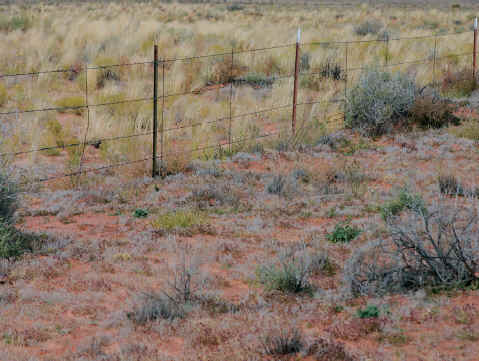 |
| This
fence
separates
land
rested
for
50
years
from
land
that's
been
grazed
for
130
years.
In
the
foreground,
the
rested
land
shows
too
clearly
why
people
who
survived
on
the
bounty
of
the
land
didn't
like
"pristine"
land.
Behind
the
fence,
grazing
and
good
management
have
created
an
oasis
of
abundance
in
a
land
with
little
rain. |
|
| Steven
H.
Rich
is
president
of
Rangeland
Restoration
Academy
in
Salt
Lake
City,
UtahFor
more
information
and
the
Web
sites
of
the
scientists
cited,
contact
Steve
atsteve@rangelandrestoration.com. |
Spring
2005
Contents |

